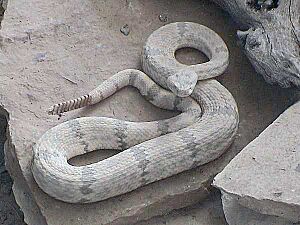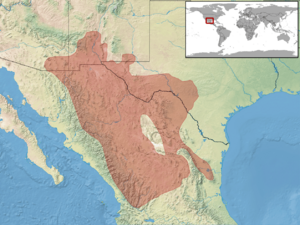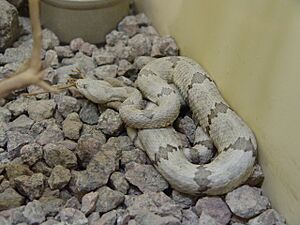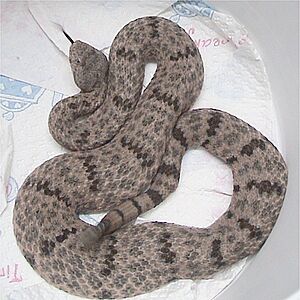Crotalus lepidus facts for kids
Quick facts for kids Crotalus lepidus |
|
|---|---|
 |
|
| Conservation status | |
| Scientific classification | |
| Genus: |
Crotalus
|
| Species: |
lepidus
|
 |
|
| Synonyms | |
The Crotalus lepidus, also known as the Rock Rattlesnake, is a type of venomous snake. It's a pit viper species found in the southwestern United States and northern central Mexico. There are four different types, or subspecies, of this snake.
Contents
About the Rock Rattlesnake
This snake is quite small. It usually grows to be less than 32 inches (81.3 cm) long. It has a large, round head and a body that is fairly thick for its size. Its eyes have pupils that look like thin lines.
Like other rattlesnakes, it has a rattle on its tail. This rattle is made of a tough material called keratin. Each time the snake sheds its skin, a new part is added to its rattle. But rattles can break off, and snakes shed their skin at different times. So, you can't tell a snake's age by counting the parts of its rattle.
The snake's color changes a lot, usually matching the rocks where it lives. Snakes found near light-colored limestone rocks are often light grey with darker grey bands. Snakes living in higher places tend to be darker. Some Rock Rattlesnakes from the Davis Mountains might even look pink! They often have dark grey spots instead of clear bands. The Banded Rock Rattlesnake (C. l. klauberi) is known for its clear, neat bands.
Cool Names for This Snake
People call the Rock Rattlesnake by many different names, like:
- Blue rattlesnake
- Eastern rock rattlesnake
- Green rattlesnake
- Little green rattlesnake
- Pink rattlesnake
- Texas rock rattlesnake
- White rattlesnake
Where They Live
You can find this snake in the Southwestern United States, including Arizona, southern New Mexico, and southwestern Texas. They also live in northern central Mexico.
How We Protect Them
The Rock Rattlesnake is listed as "Least Concern" by the IUCN Red List. This means there are many of them, they are spread out over a large area, and their numbers are not dropping quickly. In 2006, their population was stable.
However, in New Mexico, this snake is listed as a threatened species. This means it needs protection there. Its home is often in places that are hard for people to reach. So, human buildings don't threaten it much right now. But its habitat is slowly becoming more divided.
Snake Behavior
These snakes are generally not aggressive. They are very good at using their camouflage to hide. They often won't strike or even rattle their tails unless someone bothers them a lot.
They spend most of their lives in rocky areas and slopes, which is why they are called "Rock Rattlesnakes." Places where roads have been cut through rocks are often their favorite spots. They are mostly active at night. Most people who get bitten by a Rock Rattlesnake are hiking among rocks and accidentally step on or touch the snake.
What They Eat
Rock Rattlesnakes eat small mammals, lizards, and sometimes frogs. They can be more active in cooler temperatures than other types of rattlesnakes.
Rock Rattlesnakes as Pets
Two types of Rock Rattlesnakes, C. l. lepidus and C. l. klauberi, are often kept as exotic pets. You can also see them in zoos around the world. People like them because they come in many colors and are usually calm. Most of these snakes are caught in the wild. Breeding them in captivity does happen, but it's not very common. The two types found only in Mexico are rarely seen outside of Mexico.
Reproduction and Life Cycle
These snakes are ovoviviparous. This means the mother snake keeps the eggs inside her body until they hatch. She then gives birth to live young.
They breed once a year in the spring. About four months later, the mother gives birth to six to eight baby snakes. The young snakes look like tiny versions of their parents. It takes them three or more years to grow up.
About Their Venom
The venom of the Rock Rattlesnake mainly affects the blood (it's a hemotoxin). But it can also affect the nervous system (it has neurotoxic effects). If someone is bitten badly, a special medicine called antivenom is used to treat it.
Different Types of Rock Rattlesnakes
There are four recognized subspecies of the Rock Rattlesnake:
| Subspecies | Common name | Where they live |
|---|---|---|
| C. l. klauberi | Banded rock rattlesnake | Arizona, New Mexico, Texas, Mexico (south to Jalisco) |
| C. l. lepidus | Mottled rock rattlesnake | New Mexico, Texas, Mexico (Chihuahua) |
| C. l. maculosus | Durango Rock rattlesnake | Mexico (Durango, Sinaloa, Nayarit, Jalisco) |
| C. l. morulus | Tamaulipan rock rattlesnake | Mexico (Sierra Madre Oriental) |
Some recent studies suggest that the Tamaulipan Rock Rattlesnake might actually be its own separate species, called Crotalus morulus.




